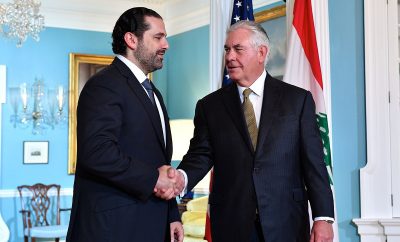 Image courtesy of [Pictures of Money via Flickr]
Image courtesy of [Pictures of Money via Flickr]
World
The Cost of Terrorism: How is ISIS Funded?
ISIS has been the focal point of public discussion for several months now and it seems like the group will not leave the spotlight anytime soon. But while we often talk about what the group is doing and how to respond, we often spend less time understanding how it is able to sustain itself. How do ISIS and other terrorist groups manage to continuously fund global operations while being attacked by several world powers?
In the case of ISIS, estimates suggest that the group’s assets equaled approximately $875 million in 2014, coming from a variety of sources that include oil production and taxes. ISIS and many other terrorist groups actually seem to resemble a sort of mix between a state government and a criminal syndicate, as their funding comes from a wide variety of sources. Read on to see where some of the money supporting ISIS, and other global terror groups, comes from.
Funding Terrorism in the Past
Traditionally terrorism has primarily been funded through private donations. This was certainly the case for ISIS’s predecessor, al-Qaida, which received much of its funding from wealthy Saudis. Charities can be effective because they are difficult to detect and tie to radical organizations. Many of these groups worked on legitimate causes while also funneling money to extremists, muddying the waters even further.
The money raised by these charities is then laundered through shell companies and some legitimate businesses, then transferred to a terrorist group. Another popular means of moving money is through remittances, which are popular in the Middle East. One example of remittances is the use of Hawalas, which are essentially untraceable wire transfers that allow people to send money from one country to their friends or relatives in another. According to a Treasury Department report, Hawalas are often cheaper and faster than traditional bank transactions, making them particularly appealing. Using middlemen with contacts in both countries, payments can be made without needing to transfer money for each transaction. While Hawalas are useful for many people who send money abroad for legitimate reasons, they are also well-liked by terrorist groups because they can be used in areas with little financial infrastructure and are hard to trace.
Efforts have been made to crack down on this type of financing–pressure has been placed both on Gulf nations, like Saudi Arabia, and financial institutions to look for any suspicious activity. While this certainly remains a viable source of income for terrorists, it has generally stopped being the number one source as governments have placed additional scrutiny on international financial transactions. Instead, ISIS and other groups have shifted to new tactics. The following video gives a look at money laundering and how terrorist groups raise funds illegally:
Help from Their Friends
While Gulf states’ support for terrorism has declined, it has certainly not been eliminated altogether. People in countries like Kuwait, Qatar, and Saudi Arabia have long been known as funders of ISIS and other extremist groups that include al-Qaida. These countries, which are in many ways American allies, argue that they are protecting Sunnis from Shiites in a larger struggle for the heart of Islam. The accompanying video looks at from where and how ISIS gets private donations, including those from American allies:
While banks, especially Western banks, have measures in place to identify money laundering and terrorist funding, the same is not true for all of the Gulf states. In places like Qatar, these controls are not as stringent and are not strongly enforced. ISIS also hires fundraisers to reach out to wealthy individuals and solicit money to support its cause.
Money can also be sent to ISIS in the form of fake humanitarian aid packages. These packages are often sent to war zones under the guise of humanitarian assistance but are not actually directed to an individual or organization. These transactions tend to be very difficult to stop for a host of reasons. In addition to poorly regulated banking systems, groups and individuals who send money are often influential in their home countries. Additionally, few humanitarian organizations have direct ties in the region to ensure that the assistance makes it to the proper aid workers.
Traditional Means
Taxes, Extortion, and Robbery
To fill the gap from private donations, ISIS, like traditional states, relies heavily on taxes. The group places a tax on everything it believes to be valuable, from businesses to vehicles. ISIS also taxes non-Muslims, giving them the choice between forced conversion, paying a tax, or facing death. These shakedowns take place at businesses, public areas, or at checkpoints, forcing people to pay or face violence and possibly death. ISIS also sends fundraisers ahead of its fighters to a town or city to demand money. It is important to note that the group only attacks and attempts to conquer areas with some sort of financial value. It rarely, for example, conquers vast tracts of desert simply to take more territory. Taxation has become an especially important source of income as its other revenue streams, like oil production, have declined. In fact, taxation and extortion were actually ISIS’s largest sources of income in 2014, amounting to a reported $600 million in revenue.
In many ways, the taxation practiced by ISIS is a form of theft, but the group also does its fair share of outright robbery. When the group took the Iraqi cities of Mosul and Tikrit last year it seized vast quantities of money from bank vaults–estimates suggest those confiscations amounted to $1.5 billion. The group is also notorious for outright stealing possessions from people when it conquers a new territory.
Kidnapping
Another means for ISIS to offset its expenses is turning to organized crime. Emulating its predecessor al-Qaida, ISIS has relied heavily on kidnapping for ransoms. ISIS’s victims are traditionally Westerners, many of whom work for wealthy organizations. Although European countries sometimes pay ransoms, some countries such as the United States will not, though some corporations will discreetly pay ransoms for their workers.
In 2014, the U.S. Treasury estimated that ISIS made as much as $20 million dollars from kidnapping. This money did not only come from abducting foreigners, it was also the result of the group’s willingness to kidnap citizens within its own territory if it feels it can generate a high enough payoff.
Drug Trafficking
Along with trafficking in people, like any criminal organization, ISIS may deal in drugs. While it is unclear how much revenue the group receives from the practice, it seems likely that drugs are one more weapon in ISIS’s financial arsenal. This is another example of ISIS learning from its predecessor Al-Qaeda.
Oil/Water/Food
While these are all important revenue streams for ISIS, its most valuable asset is the one it shares with its Middle Eastern neighbors: oil. Iraq has the fifth largest proven oil reserves in the world and ISIS uses this supply to help fill its coffers. While many of the world’s nations impose sanctions on ISIS to prevent it from selling any of these supplies, the group still manages to smuggle oil for profit. Using paths developed in Iraq during the time of Saddam Hussein, the group is able to smuggle out oil, cash, and other contraband to neighboring countries. In 2014, depending on the always-volatile price-per-barrel of oil, ISIS was making between $1 to $2 million a day off oil revenue.
Although much of the oil is smuggled illegally into neighboring countries, it may also be finding more legitimate routes. According to Russian sources, Turkey is allowing large shipments of oil from areas known to be under ISIS’s control. While this could very easily be a baseless accusation in the wake of Turkey shooting down a Russian fighter jet, it may be worth considering. David Cohen, the Undersecretary for Terrorism and Financial Intelligence at the U.S. Treasury noted that Turkey, Syria, and the Kurds have all made deals, through middlemen, to acquire oil from ISIS despite openly fighting the group.
Other Means
ISIS has also utilized other creative methods to fill its reserves. One such method is looting the historical sites that it has become notorious for destroying. Another is through its well-known skills with social media. ISIS uses apps such as WhatsApp and Kik to coordinate covert money drop-offs from its supporters. Other groups such as Boko Haram have even more innovative schemes, from acting as local muscle to employing internet scams.
Ultimately, though, how much ISIS relies on any one source and how valuable any one source is to the group tends to fluctuate a lot. After all, the group now makes far more from taxes than oil production and early sources of income like robbing banks may start to dry up. So far, this strategy has been effective as ISIS really only spends money on fighter salaries, while it salvages weapons and avoids building projects because of the threat posed by airstrikes.ISIS’s strategy is one of thriftiness, especially regarding the social services it offers to its conquered subjects, could prove more decisive than any allied bomb strike in determining its future.
The video below details how ISIS gets its money:
Conclusion
ISIS has proven to be extremely difficult to defeat by conventional means. Despite waves of airstrikes and military support for the Syrian, Kurdish, and Iraqi militaries, the group has endured and even thrived. This is a result of several factors, one of which is ISIS’s ability to draw revenue from a variety of sources while operating a crude form of local government. Another is its ability to draw revenue from a variety of sources much like a criminal enterprise. Many of these methods were pioneered by al-Qaida and are now also being adopted by Boko Haram as well.
However, ISIS’s ability to survive is also partly attributable to the difficulty, and the occasional unwillingness, of bordering countries to crack down on the flow of money to terrorist organizations. These countries have, in some cases, let ISIS smuggle goods into their countries, rampage unopposed and even somewhat directly financed its operations.
To eliminate ISIS, like al-Qaida before it, ISIS’s finances must be crippled. If you can’t pay people to fight for you, or provide services as a government, staying in power becomes increasingly difficult. However, ISIS and like-minded groups have become particularly effective at keeping the lights on.
Resources
Council on Foreign Relations: Tracking Down Terrorist Financing
Newsweek: How does ISIS fund its Reign of Terror?
The Jerusalem Post: How does the Islamic State Fund its Activities?
Security Intelligence: Funding Terrorists the Rise of ISIS
The Daily Beast: America’s Allies are Funding ISIS
RFI: Nigerian Intelligence Chief Calls for Untangling of Boko Haram Funding
Perspectives on Terrorism: A Financial Profile of the Terrorism of Al-Qaeda and its Affiliates
Political Violence at a Glance: ISIS, Ideology, and the Illicit Economy
New York Times: ISIS Finances Are Strong
Vox: This Detailed Look at ISIS’s Budget Shows That it’s Well-funded and Somewhat Incompetent








Comments